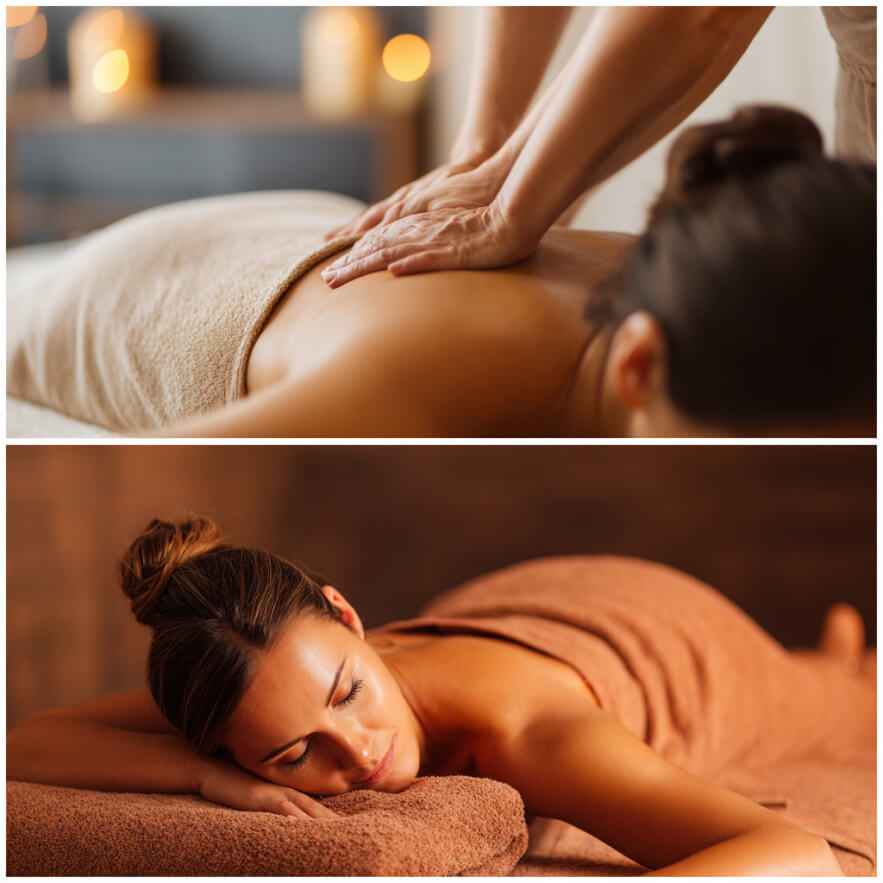Both of these massage techniques are widely used for both wellness and relaxation. But they differ significantly — in technique, sensation, and intended effects. Choosing the right type depends on how they work, what goals you have, and how your body tends to respond. The result of a session can depend not only on the therapist’s skill but also on whether the method suits your current physical and emotional state.
What is deep tissue massage and how does it work
Deep tissue massage targets the deeper layers of muscle and connective tissue. Therapists use slow, deliberate strokes with significant pressure, often involving elbows, forearms, or knuckles. The goal is to reach trigger points and tight zones to release chronic tension.
This type of massage is commonly chosen by people with persistent back, neck, shoulder, or glute pain. It’s helpful after injuries, for sedentary workers, and following intense workouts. Unlike traditional massage, it applies a level of “productive” discomfort, and the effects can last several days.
What makes it unique is the activation of deep sensory receptors and improved circulation in areas with stagnant muscle tone. It’s not relaxing in the traditional sense — people may feel tired or sore afterward. But within a day or two, the body often feels significantly “reset.”
Deep tissue shouldn’t be confused with rough handling. A skilled therapist warms up the area, assesses the tissue, and only then proceeds to deeper manipulation. The technique is controlled, anatomical, and purposeful.
Features of Swedish massage and when it’s used
Swedish massage is one of the gentlest and most popular massage types. It’s based on long, smooth strokes, gentle kneading, and rhythmic movements. The main focus is relaxing surface-level muscles, improving blood and lymph flow, and relieving mental tension.
It’s perfect for beginners, people with heightened sensitivity, or those seeking stress relief, better sleep, and a gentle recovery from fatigue. It’s often chosen after flights, during the first days of vacation, or when experiencing early signs of burnout.
The massage is performed with oil, using strokes that follow the direction of venous return. This helps reduce swelling, supports metabolism, and gently stimulates the autonomic nervous system. Techniques involve palms, fingers, and thumbs — without applying deep pressure.
Swedish massage works best as a routine wellness treatment — once or twice a week. Many people find their sleep improves, anxiety lessens, and overall resilience increases without stressing the muscles.
Physiological differences in body response
Deep tissue and Swedish massage affect the body differently — and not just in how they feel during the session. According to research published on PubMed, deep tissue massage can enhance lymphatic drainage and reduce inflammation in targeted muscle zones.
Swedish massage works gently and accumulatively. It doesn’t provoke dramatic reactions but supports the body in gradually coping with stress, fatigue, and insomnia. No special preparation or recovery is needed.
It’s important to consider your pain tolerance. Those with high sensitivity might find deep tissue unpleasant, even if performed well. Meanwhile, Swedish massage may seem “too soft” to someone who’s used to strong physical therapy.
Therapists often report clients feel energized after a Swedish session, and sleepy after deep tissue. This reflects the difference in how the nervous system processes each stimulus.
Who should choose which: indications and limitations
Choosing between these techniques depends on your health, goals, and current state. Deep tissue massage is recommended for those with:
- chronic neck or back pain;
- post-injury stiffness or tightness;
- intense muscle tone after workouts;
- sedentary lifestyle with limited movement.
Swedish massage is recommended for:
- stress and nervous tension;
- poor sleep quality;
- swelling or slow lymph flow;
- preventive care with minimal physical strain.
There are also contraindications. Deep tissue should be avoided in cases of acute inflammation, varicose veins, thrombosis, cancer, or recent fractures. Swedish massage is also not advised during fever, skin infections, or right after surgery.
Consulting a professional before either type is wise. Diagnoses and individual touch sensitivity play an important role in how your body will respond to the massage.
Looking to enhance your massage results with scent? Try custom aroma blends.
Check out our article “DIY aromatherapy blends: safe and effective recipes for home use” for exact ratios, expert tips, and unique pairings.
How to choose: advice from clients and therapists
Regular massage clients often rotate between techniques depending on their needs. For example, deep tissue once a month for muscle recovery, and Swedish weekly for emotional balance.
A good habit: assess how you feel in the morning. If you feel tight, tense, or your muscles feel “like rocks” — it may be time for a deep session. If you just want to unwind, ease mental tension, or feel more “present” — Swedish is ideal.
Some clients say deep tissue massage helps them re-engage in workouts — muscles feel more “alive.” Others find Swedish massage supports better recovery and sleep. Therapists generally confirm these observations.
If it’s your first massage ever — start with Swedish. It’s safer if you have unknown conditions. Later, you can try deep tissue, or even combine both, especially if your therapist has training in multiple techniques.
Questions and answers
Yes, if it’s physical fatigue. If you feel weak or overwhelmed, Swedish massage is a better option.
Usually 3–5 days, depending on muscle condition and lifestyle. Athletes often experience longer-lasting results.
It’s not immediate. After 2–3 sessions, people usually notice better sleep, less anxiety, and more emotional resilience.

